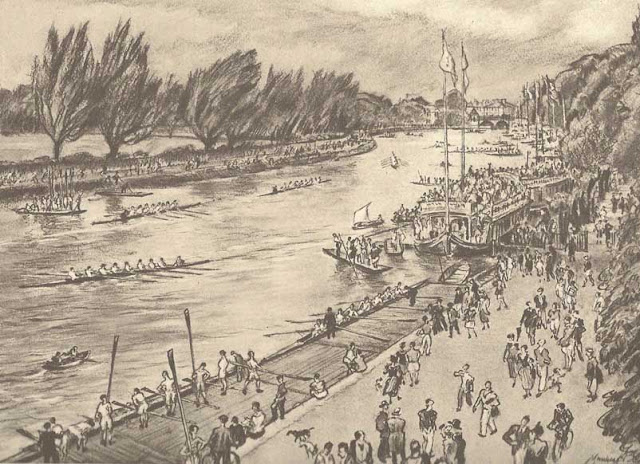Those of you who saw or read about the Boatrace a few weeks ago will be aware of one of the things the University does - as opposed to the individual colleges - is organise sports teams or crews to take on ancient rivals, Cambridge. Oxford and Cambridge try to beat each other in every sport they can think of, from American Football to darts. Team members must belong to the University in the sense that they must be undertaking a full-time course of study; this means (see previous blog) that they are all members of a college, though they may be graduate students or undergraduates. Apart from studying towards a degree the only other stipulation is that they are within a certain number of years of matriculation.
Since the end of National Service and the rise of professionalism in many sports, the general level of team sport in Oxford and Cambridge has relatively declined, but the Rugby team as well as the rowers is still of a high standard, although I couldn't say the same about tiddlywinks or croquet. In cricket, as mentioned in an earlier article, Oxford has been forced to join up with Brookes in order to maintain its first class status. If you represent Oxford against Cambridge you are a 'blue', and there is a special blues' club called Vincent's in St Edward's St., near OISE.
But the main thing that the university does is award degrees. You might say, for example, "I read law at Pembroke (College). I got an upper second and am now B.A. (Oxon)." 'Oxon' is the short form of 'Oxoniensis', i.e. Oxford in Latin. Degrees are awarded in a very formal way in the Sheldonian Theatre in the Broad, usually in the presence of the Chancellor. You have to wear gowns, etc., both to get your degree and to sit the exams. This formal attire, known as 'sub fusc', is also required for matriculation, which is the ceremony all new undergraduates attend in their first term, also in the Sheldonian.
Most first degrees at Oxford are three years, although Classics, known as 'Greats' - perhaps the most famous degree course at Oxford - is four years, as is Chemistry. However as school exams have become easier, more and more subjects are finding that four years are now needed to bring students up to the required standard. An example of this is physics which has become a four year course in recent times; undergraduates now have to complete a new first year - mostly in maths - to reach the standard of freshers of earlier years.
Generally the Oxford system is that you have only one exam to determine your degree. This is taken at the end of the summer term of your last year. It's called 'Finals' (although in my day it was called 'schools' - shows how traditions even at Oxford can change). This means that one's course is continuous - you study throughout the three (or four) year course, including vacations. OISE learners are always surprised at how short the Oxford terms are: just 3 eight week terms a year; i.e. the total vacation time - 28 weeks - is longer than term time - only 24 weeks. But don't be fooled - tutors give undergraduates piles of reading for the vacations, and then test them on the first day of the next term.
Although teaching continues to be a college activity by the weekly tutorial, the university does have a lecture programme to support the work of college tutors. These mostly take place in the Examination Schools building in the High, where most people also sit finals. But law lectures for example take place in the Law Library, near New College sportsground.
The university also provides facilities that are too big for individual colleges, and to avoid duplication. Science laboratories fall into this category, but of greater interest to a wider public, I suppose, are the world famous Bodleian Library and Oxford University Press (OUP). These are worth separate articles. Finally the university runs several museums, of which the Ashmolean is the best known.
So, here is a question: who organised May Morning? The university or the college (Magdalen, for those who failed to read the earlier piece!). Answers on my Twitter account only, please.
By Kit Villiers

